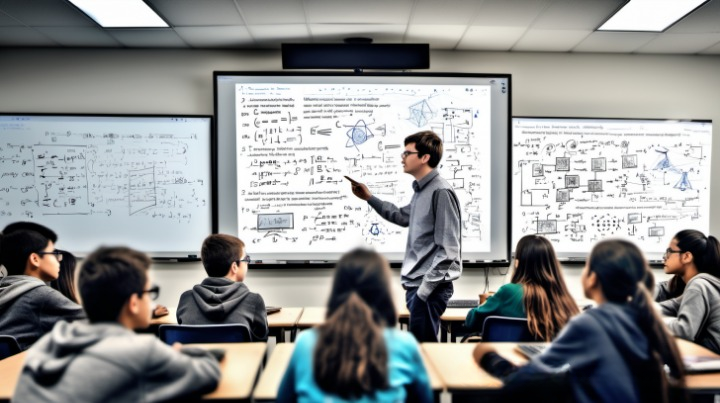Unlock the potential of Machine Learning Algorithms with this comprehensive guide. Dive deep into the world of ML, explore its various algorithms, and discover how they shape our technological landscape.
Introduction

In the digital era, Machine Learning Algorithms (MLAs) have emerged as the backbone of modern technological advancements. These sophisticated algorithms enable computers to learn from data, identify patterns, and make intelligent decisions without explicit programming. From personalized recommendations on streaming platforms to predictive analytics in healthcare, MLAs are revolutionizing industries across the globe. In this article, we embark on a journey to unravel the intricacies of Machine Learning Algorithms, exploring their types, applications, and impact on society.
Understanding Machine Learning Algorithms

Machine Learning Algorithms encompass a diverse array of techniques and methodologies designed to enable machines to learn from data and improve their performance over time. Whether it’s supervised learning, unsupervised learning, or reinforcement learning, MLAs leverage statistical models to extract valuable insights from data.
Supervised Learning:
Supervised learning involves training a model on a labeled dataset, where each input is paired with the corresponding output. By learning from this labeled data, the algorithm can make predictions or decisions when new data is encountered. Common supervised learning algorithms include linear regression, decision trees, and support vector machines.
Deep Demonstration of Supervised Learning:
Supervised learning, as the name suggests, involves the guidance of labeled data. Let’s delve deeper into some commonly used supervised learning algorithms:
1. Linear Regression: Linear regression is a fundamental algorithm used for predictive analysis. It establishes a linear relationship between input features and the target variable, allowing for the prediction of continuous outcomes. For example, in a real estate context, linear regression can be employed to predict housing prices based on factors like square footage, number of bedrooms, and location.
2. Decision Trees: Decision trees are versatile algorithms capable of handling both classification and regression tasks. They partition the data into subsets based on feature values, creating a tree-like structure where each internal node represents a decision based on a feature, and each leaf node corresponds to a predicted outcome. Decision trees are intuitive and easily interpretable, making them suitable for a wide range of applications, from healthcare diagnostics to financial risk assessment.
3. Support Vector Machines (SVM): SVM is a powerful algorithm used for classification and regression tasks. It works by finding the optimal hyperplane that separates data points belonging to different classes while maximizing the margin between classes. SVMs are particularly effective in high-dimensional spaces and are widely used in image classification, text classification, and bioinformatics.
Unsupervised Learning:
Unsupervised learning involves training a model on unlabeled data, allowing it to discover hidden patterns or structures within the dataset. Unlike supervised learning, there are no predefined outputs, and the algorithm must infer the underlying relationships present in the data. Clustering algorithms, principal component analysis (PCA), and autoencoders are common examples of unsupervised learning techniques.
Deep Demonstration of Unsupervised Learning:
Unsupervised learning delves into the realm of unknowns, where algorithms uncover hidden patterns without explicit guidance from labeled data. Let’s explore some key unsupervised learning algorithms:
1. K-Means Clustering: K-Means clustering is a popular algorithm used for partitioning data into distinct clusters based on similarity measures. It iteratively assigns data points to the nearest cluster centroid, aiming to minimize the within-cluster variance. K-Means clustering finds applications in customer segmentation, image segmentation, and anomaly detection.
2. Principal Component Analysis (PCA): PCA is a dimensionality reduction technique used to transform high-dimensional data into a lower-dimensional space while preserving the variance in the data. By identifying the principal components that capture the maximum variation, PCA facilitates data visualization, feature extraction, and noise reduction in datasets.
3. Autoencoders: Autoencoders are neural network architectures designed to learn efficient representations of input data by minimizing reconstruction errors. They consist of an encoder network that compresses the input into a latent space representation and a decoder network that reconstructs the original input from the encoded representation. Autoencoders find applications in image denoising, feature learning, and generative modeling.
Reinforcement Learning:
Reinforcement learning involves training an agent to interact with an environment and learn the optimal actions through trial and error. The agent receives feedback in the form of rewards or penalties based on its actions, enabling it to refine its strategy over time. Applications of reinforcement learning range from game playing algorithms to autonomous vehicle navigation systems.
Deep Demonstration of Reinforcement Learning:
Reinforcement learning embodies the concept of learning through experience, as agents navigate complex environments to achieve desired outcomes. Let’s delve into some notable examples of reinforcement learning applications:
1. Deep Q-Networks (DQN): DQN is a reinforcement learning algorithm that combines deep learning with Q-learning, enabling agents to learn optimal policies in complex environments. By approximating the Q-function using deep neural networks, DQN agents can effectively navigate environments with high-dimensional state spaces, such as video games and robotic control tasks.
2. Policy Gradient Methods: Policy gradient methods are a class of reinforcement learning algorithms that directly optimize the policy function, enabling agents to learn action strategies without explicitly estimating value functions. Through gradient ascent on the expected cumulative reward, policy gradient methods learn policies that maximize long-term rewards in environments with stochastic dynamics and sparse rewards.
3. Actor-Critic Methods: Actor-critic methods leverage the strengths of both policy-based and value-based approaches by training two distinct neural networks: an actor network that learns the policy and a critic network that evaluates the actions taken by the actor. By combining policy gradients with value function estimation, actor-critic methods achieve stable and efficient learning in complex reinforcement learning tasks.
Applications of Machine Learning Algorithms
Machine Learning Algorithms find applications across a myriad of industries, driving innovation and transforming business processes. Let’s explore some compelling use cases where MLAs are making a significant impact:
Healthcare
In the healthcare sector, Machine Learning Algorithms are revolutionizing patient care, diagnosis, and treatment planning. From medical imaging analysis to predictive analytics for disease prognosis, MLAs empower healthcare professionals to make informed decisions and deliver personalized treatment options.
Engaging Paragraph:
In healthcare, the integration of Machine Learning Algorithms has ushered in a new era of precision medicine, where treatment strategies are tailored to individual patients based on their unique genetic makeup and clinical history. Imagine a scenario where oncologists leverage ML-based predictive models to assess cancer risk and recommend personalized treatment regimens. By analyzing vast datasets encompassing genetic profiles, tumor characteristics, and treatment outcomes, these algorithms enable clinicians to optimize therapeutic interventions and improve patient outcomes.
Finance
In the financial industry, Machine Learning Algorithms play a pivotal role in fraud detection, risk assessment, and algorithmic trading. By analyzing vast volumes of financial data in real-time, MLAs can identify suspicious transactions, predict market trends, and optimize investment strategies, thereby enhancing operational efficiency and mitigating financial risks.
Engaging Paragraph:
Finance is a realm where milliseconds can make the difference between profit and loss, and Machine Learning Algorithms offer a competitive edge by providing actionable insights in real-time. Consider the scenario of detecting fraudulent credit card transactions in a banking system. ML-based anomaly detection algorithms analyze transaction patterns, identify deviations from normal behavior, and flag potentially fraudulent activities, enabling financial institutions to safeguard customer assets and maintain trust in the digital ecosystem.
E-commerce
In the realm of e-commerce, Machine Learning Algorithms drive personalized recommendations, dynamic pricing strategies, and customer segmentation efforts. By analyzing user behavior, purchase history, and demographic data, MLAs can tailor the shopping experience to individual preferences, thereby increasing customer satisfaction and driving revenue growth.
Engaging Paragraph:
E-commerce platforms leverage Machine Learning Algorithms to create immersive shopping experiences that resonate with individual customers. Imagine a scenario where a retail giant utilizes ML-based recommendation systems to suggest products based on browsing history, purchase patterns, and social interactions. By harnessing the power of collaborative filtering or content-based filtering, these algorithms deliver personalized product recommendations, enhancing user engagement and fostering brand loyalty.
Machine Learning Algorithms in Action
Machine Learning Algorithms are not just theoretical concepts but tangible solutions driving innovation across various domains. Let’s delve into a real-world application where MLAs are making a tangible difference:
Natural Language Processing (NLP)
Natural Language Processing (NLP) represents a subfield of Machine Learning Algorithms focused on enabling computers to understand, interpret, and generate human language. From virtual assistants like Siri and Alexa to language translation services and sentiment analysis tools, NLP algorithms empower machines to interact with humans in a seamless and intuitive manner.
Engaging Paragraph:
Natural Language Processing exemplifies the fusion of linguistics and technology, enabling machines to decipher the intricacies of human language with remarkable accuracy. Consider the scenario of developing a chatbot for customer support services. By leveraging state-of-the-art NLP algorithms like recurrent neural networks (RNNs) or transformers, organizations can automate customer interactions, address inquiries in real-time, and enhance overall service efficiency. Whether it’s resolving customer queries, processing support tickets, or facilitating online transactions, NLP-driven chatbots redefine the customer service landscape, offering round-the-clock assistance with a human touch.
Frequently Asked Questions (FAQs)
What are the different types of Machine Learning Algorithms?
Machine Learning Algorithms encompass three main types: supervised learning, unsupervised learning, and reinforcement learning. Each type has distinct characteristics and applications, catering to diverse use cases in various industries.
How do Machine Learning Algorithms learn from data?
Machine Learning Algorithms learn from data through a process of training, where they analyze patterns and relationships within the dataset to make predictions or decisions. Supervised learning algorithms learn from labeled data, unsupervised learning algorithms uncover hidden patterns in unlabeled data, and reinforcement learning algorithms learn through trial and error interactions with an environment.
What are some common applications of Machine Learning Algorithms?
Machine Learning Algorithms find applications across a wide range of industries, including healthcare (for diagnosis, treatment planning, and patient monitoring), finance (for fraud detection, risk assessment, and algorithmic trading), e-commerce (for personalized recommendations, dynamic pricing, and customer segmentation), and natural language processing (for virtual assistants, language translation, and sentiment analysis).
How are Machine Learning Algorithms changing the future of technology?
Machine Learning Algorithms are driving innovation and shaping the future of technology by enabling automation, personalization, and intelligent decision-making across various domains. From self-driving cars and virtual assistants to predictive analytics and personalized medicine, MLAs are transforming the way we interact with technology and revolutionizing industries.
What are the challenges associated with implementing Machine Learning Algorithms?
Implementing Machine Learning Algorithms can pose several challenges, including data quality issues, algorithm selection, model interpretability, scalability, and ethical considerations. Ensuring the reliability and fairness of ML models, addressing biases in data, and maintaining transparency in decision-making processes are crucial factors to consider when deploying ML solutions.
How can businesses leverage Machine Learning Algorithms to gain a competitive advantage?
Businesses can leverage Machine Learning Algorithms to gain a competitive advantage by harnessing the power of data-driven insights to optimize processes, enhance customer experiences, and drive innovation. By integrating MLAs into various aspects of their operations, organizations can unlock new opportunities for growth, efficiency, and profitability.
Conclusion
Machine Learning Algorithms represent a transformative force in the digital landscape, offering unparalleled capabilities for data analysis, pattern recognition, and decision-making. From predicting customer preferences to diagnosing medical conditions, MLAs are reshaping industries and driving innovation at an unprecedented pace. By understanding the fundamentals of supervised learning, unsupervised learning, and reinforcement learning, businesses can harness the full potential of MLAs to gain a competitive edge in today’s data-driven world.




